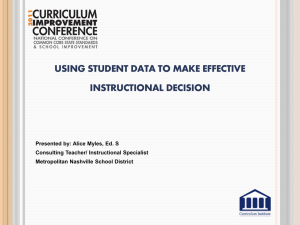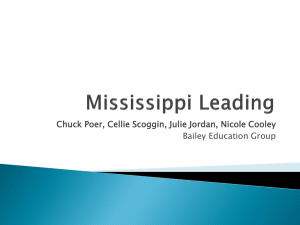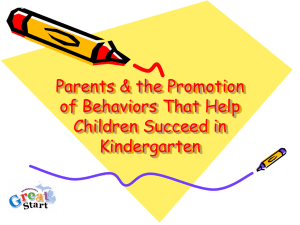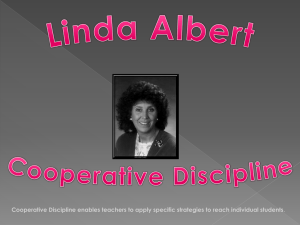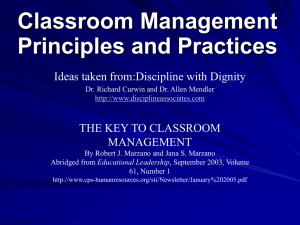The Framework for Teaching - Prince George`s County Public
advertisement
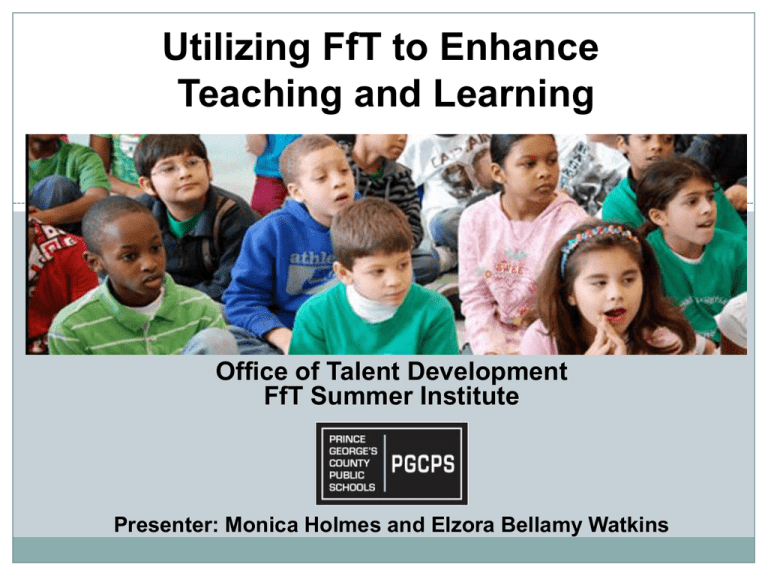
Utilizing FfT to Enhance Teaching and Learning Office of Talent Development FfT Summer Institute Presenter: Monica Holmes and Elzora Bellamy Watkins “Quote of the Day” Learning how to learn is life’s most important skill. Anonymous Agenda Warm up (10 mins) FfT topic Introductory Activity (15 mins.) What are the pieces? Challenging Components and Elements Let’s take a Look (15 mins) All Roads Lead to… (25 mins) Closure (2 mins) Outcome Participants will understand how the FfT will be better able to support teachers in enhancing teaching and learning. The Framework for Teaching Charlotte Danielson You Talk a Mile a Minute You Talk a Mile a Minute The subject is FFT Self Assessment Research Student Centered Cognitive Constructivist Reflective Domains observation 00 01 02 03 04 05 06 07 08 09 10 11 12 13 14 15 16 17 18 19 20 21 22 23 24 25 26 27 28 29 30 31 32 33 34 35 36 37 38 39 40 41 42 43 44 45 46 47 48 49 50 51 52 53 54 55 56 57 58 1 59 You Talk a Mile a Minute The subject is FFT Self Assessment Research Student Centered Cognitive Constructivist Reflective Domains observation 00 01 02 03 04 05 06 07 08 09 10 11 12 13 14 15 16 17 18 19 20 21 22 23 24 25 26 27 28 29 30 31 32 33 34 35 36 37 38 39 40 41 42 43 44 45 46 47 48 49 50 51 52 53 54 55 56 57 58 59 Round 2 You Talk a Mile a Minute The subject is FFT Culture Question Planning and preparation Rigor Activity Discussion Turn and talk Professional responsibility 00 01 02 03 04 05 06 07 08 09 10 11 12 13 14 15 16 17 18 19 20 21 22 23 24 25 26 27 28 29 30 31 32 33 34 35 36 37 38 39 40 41 42 43 44 45 46 47 48 49 50 51 52 53 54 55 56 57 58 1 59 You Talk a Mile a Minute The subject is FFT Culture Question Planning and preparation Rigor Activity Discussion Turn and talk Professional responsibility 00 01 02 03 04 05 06 07 08 09 10 11 12 13 14 15 16 17 18 19 20 21 22 23 24 25 26 27 28 29 30 31 32 33 34 35 36 37 38 39 40 41 42 43 44 45 46 47 48 49 50 51 52 53 54 55 56 57 58 59 Rate yourself 1. I’m brand new at the FfT 2. I’m a little familiar with the FfT 3. I’ve trained or participated in the Pilot or FIRST The Framework for Teaching Charlotte Danielson Framework for Teaching Organization Domains (1, 2, 3, and 4) Components (8 Essentials) Elements (26) The Framework for Teaching Domain 1 Domain 2 Planning and Preparation The Classroom Environment Domain 4 Domain 3 Professional Responsibilities Instruction The Framework for Teaching Charlotte Danielson Jigsaw You have 15 minutes to place the elements under the appropriate elements, and the components under the appropriate Domains. What are some observations you can tell about the elements? The 8 Essential Components Domain 1: Domain 2: Planning and Preparation Classroom Environment 1c: Establishing Instructional Outcomes 2b: Establishing a Culture for Learning 1e: Designing Coherent Instruction 2d: Managing Student Behavior Domain 4: Domain 3: Professional Responsibility Instruction 4a: Reflecting on Teaching 3b: Using Questioning and Discussion Techniques 4c: Communicating with Families 3c: Engaging Student in Learning 1 4 The Framework for Teaching Charlotte Danielson 2 3 Priorities of the FFT What are the FFT has two priorities? Cognitive engagement “minds-on” Constructivist learning “learning is done by the learner” Teaching cannot be considered Proficient or Distinguished if students are not thinking and doing the learning themselves. Domain 3: Instruction Component 3b: Questioning & Discussion Techniques Elements: Quality of Questions, Discussion Techniques, Student Participation Element Quality of Questions Discussion techniques Student participatio n Unsat Basic Proficient Distinguished Teacher’s questions are a combination of low and high quality, posed in rapid succession. Only some invite a thoughtful response. Most of the teacher’s questions are of high quality. Adequate time is provided for students to respond. Teacher’s questions are of uniformly high quality, with adequate time for students to respond. Students formulate many questions. Teacher makes some attempt to engage students in genuine discussion rather than recitation, with uneven results. Teacher creates a genuine discussion among students, stepping aside when appropriate. Students assume considerable responsibility for the success of the discussion, initiating topics and making unsolicited contributions. Teacher attempts to engage all students in the discussion, but with only limited success. Teacher successfully engages all students in the discussion. Students themselves ensure that all voices are heard in the discussion Clip Talk What evidence of Cognitive engagement and constructivist learning do you see or hear? CLIPS We will be viewing a series of clips of a ninth grade Algebra 1 lesson. What are the Behaviors needed to enhance teaching and learning? What would be some student behaviors that depicts cognitive engagement and constructivist learning? What teacher behaviors should be evident to bring about these student behavior? All Roads Lead to… What to consider as you plan… Academic Rigor in a Thinking Curriculum Commitment to a Knowledge Core High Thinking Demand Active Use of Knowledge PRINCE GEORGE’S COUNTY BOARD OF EDUCATION • PRINCE GEORGE’S COUNTY PUBLIC SCHOOLS www.pgcps.org 27 Commitment to a Knowledge Core Includes: An articulated curriculum that avoids needless repetition and progressively deepens concepts Curriculum and instruction that is organized around major concepts Teaching and assessment that focus on the mastery of core concepts PRINCE GEORGE’S COUNTY BOARD OF EDUCATION • PRINCE GEORGE’S COUNTY PUBLIC SCHOOLS www.pgcps.org 28 High Thinking Demand Students are expected to raise questions, to solve problems, and to reason. Challenging assignments are included in every subject. Extended projects are a part of the curriculum. Explanations and justification of ideas and opinions are expected of all students. Reflection on learning strategies is evident in discussion and student work. PRINCE GEORGE’S COUNTY BOARD OF EDUCATION • PRINCE GEORGE’S COUNTY PUBLIC SCHOOLS www.pgcps.org 29 Active Use of Knowledge Students are expected to: synthesize several sources of information, test understanding by applying and discussing concepts, apply prior knowledge, and interpret texts and construct solutions. PRINCE GEORGE’S COUNTY BOARD OF EDUCATION • PRINCE GEORGE’S COUNTY PUBLIC SCHOOLS www.pgcps.org 30 1c: Setting Instructional Outcomes Pieces of the Lesson: Value, Sequence, & Alignment Clarity Balance Suitability for Diverse Learners Looking at the lesson plan Domain 1: Planning and Preparation Component 1c: Establishing Instructional Outcomes Elements: Value, Sequence, and alignment, Clarity, Balance, Suitability for diverse learners Element Unsatisfactory Basic Proficient Distinguished Value and Sequence Outcomes represent low expectations for students and lack of rigor. They do not reflect important learning in the discipline nor a connection to a sequence of learning. Outcomes represent moderately high expectations and rigor. Some reflect important learning in the discipline and at least some connection to a sequence of learning. Most outcomes represent high expectations and rigor, and important learning in the discipline. They are connected to a sequence of learning. All outcomes represent high expectations and rigor, and important learning in the discipline. They are connected to a sequence of learning both in the discipline and related disciplines. Clarity Outcomes are either not clear or are stated as not as student learning but as activities. Outcomes do not permit viable methods of assessment. Outcomes are only moderately clear, or consist of a combination of outcomes and activities. Some outcomes permit viable methods of assessment. Most of the outcomes are clear, but may include a few activities. Most suggest viable methods of assessment. All the outcomes are clearing, written in the form of student learning, and permit viable methods of assessment. Balance Outcomes reflect only one type of learning and only one discipline or strand. Outcomes reflect several types of learning but teacher has made no attempt at coordination or integration. Outcomes reflect several different types of learning and opportunities for coordination. Where appropriate, outcomes reflect several different types of learning and opportunities for both coordination and integration. Suitability for Diverse learners Outcomes are not suitable for the class, or are not based on any assessment of student needs. Most of the outcomes are suitable for most of the students in the class based on global assessments of student learning. Most of the outcomes are suitable for all students in the class, and are based on evidence of student proficiency. However, the needs of some individual students may not be accommodated. Outcomes are based on a comprehensive assessment of student learning and take into account the varying needs of individual students or groups. 32 Domain 1: Planning and Preparation Component 1e: Designing Coherent Instruction Elements: Learning activities, Instructional materials and resources, Instructional groups, Lesson and unit structure Element Unsatisfactory Basic Proficient Distinguished Learning Activities Learning activities are not suitable to students or to instructional purposes, and are not designed to engage students in active intellectual activity. Only some of the learning activities are suitable to students or to the instructional outcomes. Some represent a moderate cognitive challenge, but with no differentiation for different students. All of the learning activities are suitable to students or to the instructional outcomes, and most represent significant cognitive challenge, and with some differentiation for different groups of students. Learning activities are highly suitable to diverse learners and support the instructional outcomes. They are all designed to engage students in highlevel cognitive activity, and are differentiated, as appropriate, for individual learners. Instructional Materials and Resources Materials and resources are not suitable for students, do not support the instructional outcomes nor engage students in meaningful learning. Some of the materials and resources are suitable to students, support the instructional outcomes, and engage students in meaningful learning. All of the materials and resources are suitable to students, support the instructional outcomes, and are designed to engage students in meaningful learning. All of the materials and resources are suitable to students, support the instructional outcomes, and are designed to engage students in meaningful learning. There is evidence of appropriate use of technology and of student participation in selecting or adapting materials. Instructional Groups Instructional groups do not support the instructional outcomes and offer no variety. Instructional groups partially support the instructional outcomes, with an effort at providing some variety. Instructional groups are varied as appropriate to the students and the different instructional outcomes. Instructional groups are varied as appropriate to the students and the different instructional outcomes. There is evidence of student choice in selecting the different patterns of instructional groups. Lesson and Unit Structure The lesson or unit has no clearly defined structure, or the structure is chaotic. Activities do not follow an organized progression, and time allocations are unrealistic. The lesson or unit has a recognizable structure, although the structure is not uniformly maintained throughout. Progression of activities is uneven, most time allocations are reasonable The lesson or unit has a clearly defined structure around which activities are organized. Progression of activities is even, with reasonable time allocations. The lesson’s or unit’s structure is clear and allows for different pathways according to diverse student needs. The progression of activities is highly coherent. 33 2 Minute Quick Write How would todays information have implications on your work? 00 01 02 03 04 05 06 07 08 09 10 11 12 13 14 15 16 17 18 19 20 21 22 23 24 25 26 27 28 29 30 31 32 33 34 35 36 37 38 39 40 41 42 43 44 45 46 47 48 49 50 51 52 53 54 55 56 57 58 1 59 2 Minute Quick Write How would todays information have implications on your work? 00 01 02 03 04 05 06 07 08 09 10 11 12 13 14 15 16 17 18 19 20 21 22 23 24 25 26 27 28 29 30 31 32 33 34 35 36 37 38 39 40 41 42 43 44 45 46 47 48 49 50 51 52 53 54 55 56 57 58 59 Domain 1: Planning and Preparation Component 1c: Establishing Instructional Outcomes Elements: Value, Sequence, and alignment, Clarity, Balance, Suitability for diverse learners Element Unsatisfactory Basic Proficient Distinguished Value and Sequence Outcomes represent low expectations for students and lack of rigor. They do not reflect important learning in the discipline nor a connection to a sequence of learning. Outcomes represent moderately high expectations and rigor. Some reflect important learning in the discipline and at least some connection to a sequence of learning. Most outcomes represent high expectations and rigor, and important learning in the discipline. They are connected to a sequence of learning. All outcomes represent high expectations and rigor, and important learning in the discipline. They are connected to a sequence of learning both in the discipline and related disciplines. Clarity Outcomes are either not clear or are stated as not as student learning but as activities. Outcomes do not permit viable methods of assessment. Outcomes are only moderately clear, or consist of a combination of outcomes and activities. Some outcomes permit viable methods of assessment. Most of the outcomes are clear, but may include a few activities. Most suggest viable methods of assessment. All the outcomes are clearing, written in the form of student learning, and permit viable methods of assessment. Balance Outcomes reflect only one type of learning and only one discipline or strand. Outcomes reflect several types of learning but teacher has made no attempt at coordination or integration. Outcomes reflect several different types of learning and opportunities for coordination. Where appropriate, outcomes reflect several different types of learning and opportunities for both coordination and integration. Suitability for Diverse learners Outcomes are not suitable for the class, or are not based on any assessment of student needs. Most of the outcomes are suitable for most of the students in the class based on global assessments of student learning. Most of the outcomes are suitable for all students in the class, and are based on evidence of student proficiency. However, the needs of some individual students may not be accommodated. Outcomes are based on a comprehensive assessment of student learning and take into account the varying needs of individual students or groups. 37 Value and Sequence Element Unsatisfactory Value and Outcomes Sequence represent low expectations for students and lack of rigor. They do not reflect important learning in the discipline nor a connection to a sequence of learning. Basic Proficient Distinguished Outcomes represent moderately high expectations and rigor. Some reflect important learning in the discipline and at least some connection to a sequence of learning. Most outcomes represent high expectations and rigor, and important learning in the discipline. They are connected to a sequence of learning. All outcomes represent high expectations and rigor, and important learning in the discipline. They are connected to a sequence of learning both in the discipline and related disciplines. Value and Sequence Element Unsatisfactory Value and Outcomes Sequence represent low expectations for students and lack of rigor. They do not reflect important learning in the discipline nor a connection to a sequence of learning. Basic Proficient Distinguished Outcomes represent moderately high expectations and rigor. Some reflect important learning in the discipline and at least some connection to a sequence of learning. Most outcomes represent high expectations and rigor, and important learning in the discipline. They are connected to a sequence of learning. All outcomes represent high expectations and rigor, and important learning in the discipline. They are connected to a sequence of learning both in the discipline and related disciplines. Pieces of the Lesson Value, Sequence, & Alignment Aligned to standards Part of a bigger picture, previous lesson, beginning lesson, etc. Represents high expectations & intellectual rigor (higher order thinking) Value, Sequence and Alignment Connected to a sequence of learning both in the discipline and in related disciplines. Does this outcome connect to what students are learning in other disciplines? Is this important learning? Does the learning outcome represent high expectation for all students? Is the learning outcome rigorous? If not, how might you rewrite it to be more rigorous? Does the outcome naturally follow what students have previously learned? Domain 1: Planning and Preparation Component 1c: Establishing Instructional Outcomes Elements: Value, Sequence, and alignment, Clarity, Balance, Suitability for diverse learners Element Unsatisfactory Basic Proficient Distinguished Value and Sequence Outcomes represent low expectations for students and lack of rigor. They do not reflect important learning in the discipline nor a connection to a sequence of learning. Outcomes represent moderately high expectations and rigor. Some reflect important learning in the discipline and at least some connection to a sequence of learning. Most outcomes represent high expectations and rigor, and important learning in the discipline. They are connected to a sequence of learning. All outcomes represent high expectations and rigor, and important learning in the discipline. They are connected to a sequence of learning both in the discipline and related disciplines. Clarity Outcomes are either not clear or are stated as not as student learning but as activities. Outcomes do not permit viable methods of assessment. Outcomes are only moderately clear, or consist of a combination of outcomes and activities. Some outcomes permit viable methods of assessment. Most of the outcomes are clear, but may include a few activities. Most suggest viable methods of assessment. All the outcomes are clearing, written in the form of student learning, and permit viable methods of assessment. Balance Outcomes reflect only one type of learning and only one discipline or strand. Outcomes reflect several types of learning but teacher has made no attempt at coordination or integration. Outcomes reflect several different types of learning and opportunities for coordination. Where appropriate, outcomes reflect several different types of learning and opportunities for both coordination and integration. Suitability for Diverse learners Outcomes are not suitable for the class, or are not based on any assessment of student needs. Most of the outcomes are suitable for most of the students in the class based on global assessments of student learning. Most of the outcomes are suitable for all students in the class, and are based on evidence of student proficiency. However, the needs of some individual students may not be accommodated. Outcomes are based on a comprehensive assessment of student learning and take into account the varying needs of individual students or groups. 42 Clarity Element Unsatisfactory Basic Proficient Distinguished Clarity Outcomes are either not clear or are stated as not as student learning but as activities. Outcomes do not permit viable methods of assessment. Outcomes are only moderately clear, or consist of a combination of outcomes and activities. Some outcomes permit viable methods of assessment. Most of the outcomes are clear, but may include a few activities. Most suggest viable methods of assessment. All the outcomes are clearing, written in the form of student learning, and permit viable methods of assessment. Pieces of the Lesson Clarity Objectives use measurable verbs Clearly stated as a learning goal & can be assessed Teacher states outcome as learning not just as an activity Outcomes can be assessed/tested What’s the difference between Activity and Outcome? Outcome What students are expected to learn Worthwhile and represent learning central to a discipline as well high level learning for the students The result or consequence of an activity in terms of success and failure Activity What students will do A single focus thing that the student does An educational process or procedure intended to stimulate learning through actual experience Outcome The outcome is not that the student will complete page 38 and answer the questions but what will they learn as a consequence of answering the question on page 38. Clarity-Teacher states outcome as learning not just as an activity Bringing Clarity, is it an activity or an outcome? Outcome: Today you will use your problem-solving skills to resolve the following dilemma… Activity: Read question #3 on page 47. work with a partner to answer the question. (This outcome is not about the answer to the dilemma, but rather the thinking students engage in to come to a resolution. The outcome allows the teacher to uncover how students are thinking about a situation and provides an opportunity to probe for deeper thinking.) Instructional Outcomes do not describe what students will do, but what they will learn. Domain 1: Planning and Preparation Component 1c: Establishing Instructional Outcomes Elements: Value, Sequence, and alignment, Clarity, Balance, Suitability for diverse learners Element Unsatisfactory Basic Proficient Distinguished Value and Sequence Outcomes represent low expectations for students and lack of rigor. They do not reflect important learning in the discipline nor a connection to a sequence of learning. Outcomes represent moderately high expectations and rigor. Some reflect important learning in the discipline and at least some connection to a sequence of learning. Most outcomes represent high expectations and rigor, and important learning in the discipline. They are connected to a sequence of learning. All outcomes represent high expectations and rigor, and important learning in the discipline. They are connected to a sequence of learning both in the discipline and related disciplines. Clarity Outcomes are either not clear or are stated as not as student learning but as activities. Outcomes do not permit viable methods of assessment. Outcomes are only moderately clear, or consist of a combination of outcomes and activities. Some outcomes permit viable methods of assessment. Most of the outcomes are clear, but may include a few activities. Most suggest viable methods of assessment. All the outcomes are clearing, written in the form of student learning, and permit viable methods of assessment. Balance Outcomes reflect only one type of learning and only one discipline or strand. Outcomes reflect several types of learning but teacher has made no attempt at coordination or integration. Outcomes reflect several different types of learning and opportunities for coordination. Where appropriate, outcomes reflect several different types of learning and opportunities for both coordination and integration. Suitability for Diverse learners Outcomes are not suitable for the class, or are not based on any assessment of student needs. Most of the outcomes are suitable for most of the students in the class based on global assessments of student learning. Most of the outcomes are suitable for all students in the class, and are based on evidence of student proficiency. However, the needs of some individual students may not be accommodated. Outcomes are based on a comprehensive assessment of student learning and take into account the varying needs of individual students or groups. 49 Balance Element Balance Unsatisfactory Basic Proficient Distinguished Outcomes reflect only one type of learning and only one discipline or strand. Outcomes reflect several types of learning but teacher has made no attempt at coordination or integration. Outcomes reflect several different types of learning and opportunities for coordination. Where appropriate, outcomes reflect several different types of learning and opportunities for both coordination and integration. Balance Balance Balance represent factual knowledge and procedural skills as well as thinking and reasoning, conceptual understanding and skills in collaboration. Among different types of learning (may represent listening, discussion, writing, drawing, presenting, groupings, etc.) How is it related to the learning outcome? Integrated with other content areas/technology Domain 1: Planning and Preparation Component 1c: Establishing Instructional Outcomes Elements: Value, Sequence, and alignment, Clarity, Balance, Suitability for diverse learners Element Unsatisfactory Basic Proficient Distinguished Value and Sequence Outcomes represent low expectations for students and lack of rigor. They do not reflect important learning in the discipline nor a connection to a sequence of learning. Outcomes represent moderately high expectations and rigor. Some reflect important learning in the discipline and at least some connection to a sequence of learning. Most outcomes represent high expectations and rigor, and important learning in the discipline. They are connected to a sequence of learning. All outcomes represent high expectations and rigor, and important learning in the discipline. They are connected to a sequence of learning both in the discipline and related disciplines. Clarity Outcomes are either not clear or are stated as not as student learning but as activities. Outcomes do not permit viable methods of assessment. Outcomes are only moderately clear, or consist of a combination of outcomes and activities. Some outcomes permit viable methods of assessment. Most of the outcomes are clear, but may include a few activities. Most suggest viable methods of assessment. All the outcomes are clearing, written in the form of student learning, and permit viable methods of assessment. Balance Outcomes reflect only one type of learning and only one discipline or strand. Outcomes reflect several types of learning but teacher has made no attempt at coordination or integration. Outcomes reflect several different types of learning and opportunities for coordination. Where appropriate, outcomes reflect several different types of learning and opportunities for both coordination and integration. Suitability for Diverse learners Outcomes are not suitable for the class, or are not based on any assessment of student needs. Most of the outcomes are suitable for most of the students in the class based on global assessments of student learning. Most of the outcomes are suitable for all students in the class, and are based on evidence of student proficiency. However, the needs of some individual students may not be accommodated. Outcomes are based on a comprehensive assessment of student learning and take into account the varying needs of individual students or groups. 54 Suitability for Diverse learners Element Unsatisfactory Basic Proficient Suitability for Diverse learners. Outcomes are not suitable for the class, or are not based on any assessment of student needs. Most of the outcomes are suitable for most of the students in the class based on global assessments of student learning Most of the outcomes are suitable for all students in the class, and are based on evidence of student proficiency. However, the needs of some individual students may not be accommodated. Distinguished Outcomes are based on a comprehensive assessment of student learning and take into account the varying needs of individual students or groups. Suitability for Diverse Learners Instruction is adjusted to accommodate diverse learners Differentiating the Process/Activities Differentiating the processes means varying learning activities or strategies to provide appropriate methods for students to explore the concepts. Priorities of the FFT The FFT has two priorities Cognitive engagement “minds-on” Constructivist learning “learning is done by the learner” Teaching cannot be considered Proficient or Distinguished if students are not thinking and doing the learning themselves.

